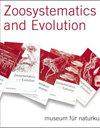美索不达米亚、西里西亚和黎凡特鲤科一新属(鲤形目,鲤形目)
IF 0.9
2区 生物学
Q2 ZOOLOGY
引用次数: 2
摘要
在这项研究范围内进行的分子和形态学研究表明,被称为美索不达米亚人的刮刀属于一个不同的属。Paracapoetagen。来自美索不达米亚和黎凡特的nov.,与Capoeta和Luciobarbus种类的区别在于,在背鳍的最后一个单根和第一个分支射线的基部之间存在一个强大的韧带(相对于没有或非常弱的韧带)。Paracapoeta与Capoeta的进一步区别在于,最后一条简单的背鳍射线在成年标本中强烈骨化(超过75%,对小于75%)。下唇有角质层(相对于肉质嘴唇),这进一步区别于Luciobarbus。基于COI + Cytb, 1312 bp.的分子系统发育分析表明,Paracapoeta属是从Barbinae亚科其他类群中恢复出来的,具有较高的bootstrap和后验概率值(bp: 94%, PP: 0.96)。Paracapoeta和Capoeta分化良好,平均遗传距离为8.02±0.78%。形态学和分子的发现在很大程度上相互重叠。此外,Capoeta turani被视为Capoeta erhani的同义词。本文章由计算机程序翻译,如有差异,请以英文原文为准。
Paracapoeta, a new genus of the Cyprinidae from Mesopotamia, Cilicia and Levant (Teleostei, Cypriniformes)
The molecular and morphological studies carried out within the scope of this study revealed that the scrapers, known as the Mesopotamian group, belong to a different genus. The Paracapoetagen. nov., from the Mesopotomia and Levant, is distinguished from Capoeta and Luciobarbus species by the presence of a strong ligament between the base of the last simple and the first branched rays of the dorsal-fin (vs. no or a very weak ligament). The Paracapoeta further differs from Capoeta by the last simple dorsal-fin ray strongly ossified in adult specimens (more than 75%, vs. less than 75%). The Paracapoeta further differs from Luciobarbus by the lower lip with horny layer (vs. fleshy lips). The molecular phylogeny based on the combined dataset (COI + Cytb, 1312 bp.) showed that the genus Paracapoeta was recovered from the other groups in the subfamily Barbinae with high bootstrap and posterior probability values (BP: 94%, PP: 0.96). Also, Paracapoeta and Capoeta are well differentiated by an average genetic distance of 8.02±0.78%. The morphological and molecular findings have largely overlapped each other. Besides, Capoeta turani is treated as a synonym of Capoeta erhani.
求助全文
通过发布文献求助,成功后即可免费获取论文全文。
去求助
来源期刊

Zoosystematics and Evolution
ZOOLOGY-
CiteScore
3.50
自引率
5.00%
发文量
34
审稿时长
16 weeks
期刊介绍:
Zoosystematics and Evolution, formerly Mitteilungen aus dem Museum für Naturkunde in Berlin, is an international, open access, peer-reviewed life science journal devoted to whole-organism biology. It publishes original research and review articles in the field of Metazoan taxonomy, biosystematics, evolution, morphology, development and biogeography at all taxonomic levels. The journal''s scope encompasses primary information from collection-related research, taxonomic descriptions and discoveries, revisions, annotated type catalogues, aspects of the history of science, and contributions on new methods and principles of systematics. Articles whose main topic is ecology, functional anatomy, physiology, or ethology are only acceptable when of systematic or evolutionary relevance and perspective.
 求助内容:
求助内容: 应助结果提醒方式:
应助结果提醒方式:


